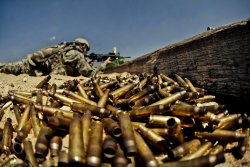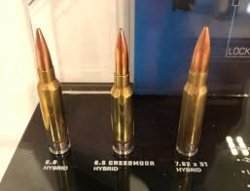Steal2B
.700 Nitro Express
Will the U.S. Army follow through on a plan to adopt a bigger caliber of small arms ammunition?

Murakhovsky also questioned the economics of switching from 5.56-mm to 6.8-mm. "This is the cost of the small arms industry’s switchover to this caliber and [the creation] of mobilization reserves. The number of rounds fired in a big war amounts to billions of cartridges a year. During the Cold War period, when the stake was on the victory of capitalism, all the NATO members switched over from the 7.62mm to the 5.56mm caliber. But what funds will they use now to switch over to the new caliber?"
Some 5.56-mm rounds can already penetrate Russian and Chinese body armor. "A round exists for the 5.56-mm caliber, which ‘pierces’ any armor vests at a distance of half a kilometer," Murakhovsky said. But the “cost is extremely high because its core is made of tungsten carbide" and, therefore, it cannot be mass produced, he added.
The Russian expert could not resist taking a dig at the U.S. Army’s long and fruitless effort to develop a replacement for the 1990s M-4, which itself is mostly based on the 1960s M-16 (which had a rocky start when first issued during the Vietnam War).
“I remember all these [American] next-generation programs from the time when I was a lieutenant,” Murakhovsky said. “And whatever they tried: the 4.7-mm caliber, caseless cartridges and rocket bullets. This story will last forever.”

 nationalinterest.org
nationalinterest.org

Murakhovsky also questioned the economics of switching from 5.56-mm to 6.8-mm. "This is the cost of the small arms industry’s switchover to this caliber and [the creation] of mobilization reserves. The number of rounds fired in a big war amounts to billions of cartridges a year. During the Cold War period, when the stake was on the victory of capitalism, all the NATO members switched over from the 7.62mm to the 5.56mm caliber. But what funds will they use now to switch over to the new caliber?"
Some 5.56-mm rounds can already penetrate Russian and Chinese body armor. "A round exists for the 5.56-mm caliber, which ‘pierces’ any armor vests at a distance of half a kilometer," Murakhovsky said. But the “cost is extremely high because its core is made of tungsten carbide" and, therefore, it cannot be mass produced, he added.
The Russian expert could not resist taking a dig at the U.S. Army’s long and fruitless effort to develop a replacement for the 1990s M-4, which itself is mostly based on the 1960s M-16 (which had a rocky start when first issued during the Vietnam War).
“I remember all these [American] next-generation programs from the time when I was a lieutenant,” Murakhovsky said. “And whatever they tried: the 4.7-mm caliber, caseless cartridges and rocket bullets. This story will last forever.”

Russian Expert: The U.S. Can’t Afford New 6.8-mm Rifle Ammo
Will the U.S. Army follow through on a plan to adopt a bigger caliber of small arms ammunition? One Russian expert says no. Viktor Murakhovsky, editor-in-chief of Russian defense journal Arsenal of the Fatherland, questions the practicality of the U.S. Army’s project to replace the familiar...






